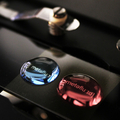Tailored optical material from DNA:
Light-modifying nanoparticles

Right-handed and left-handed nano spiral staircases differ visibly in their interaction with circular polarized light. Photo: Tim Liedl / LMU
14.03.2012, Press releases
In the human body genetic information is encoded in double-stranded deoxyribonucleic acid building blocks, the so-called DNA. Using artificial DNA molecules, an international team of scientists headed by the Cluster of Excellence Nanosystems Initiative Munich (NIM) has produced nanostructured materials that can be used to modify visible light by specification. The researchers present their results in the current issue of the renowned scientific journal “Nature.”
There was a lot of excitement a few years ago following the discovery of the DNA origami technique. The approach could be used to build nanoparticles of a given shape and size. However, real applications, such as nano-tweezers, remained out of reach. An international team of researchers led by Professor Tim Liedl of the Ludwig-Maximillians-Universitaet Muenchen and Professor Friedrich Simmel of the Technische Universitaet Muenchen have now succeeded in building nanoparticles using optically active DNA building blocks that can be used to modify light in very specific ways.
Coupling light and nanostructures may help significantly reduce the size of optical sensors for medical and environmental applications, while at the same time making them more sensitive. However, the size of a light wave stretching out over 400 to 800 nanometers is gigantic in comparison to nanostructures of only a few nanometers. Yet in theory, when tiniest structures work together in very specific ways, even small objects can interact very well with light. Unfortunately it is not possible to produce the requisite three-dimensional structures with nano-scale precision in sufficient quantities and purity using conventional methods.
“With DNA origami, we have now found a methodology that fulfills all of these requirements. It makes it possible to define in advance and with nanometer precision the three-dimensional shape of the object being created,” says Professor Friedrich Simmel, who holds the Chair for Biomolecular Systems and Bionanotechnology at the TU Muenchen. Programmed solely using the sequence of basic building blocks, the nano-elements fold themselves into the desired structures.” Friedrich Simmel’s team successfully built nano spiral staircases 57 nanometers high and 34 nanometers in diameter with 10 nanometer gold particles attached at regular intervals.
On the surface of the gold particles the electrons react with the electromagnetic field of the light. The small clearance between the particles ensures that the gold particles of a DNA strand work in unison, thereby amplifying the interactions many fold. Professor Alexander O. Govorov, theoretical physicist at the Ohio State University in Athens, USA, had predicted that the effect should depend on the spacing, size and composition of the metal particles. Using the DNA origami method, the Munich physicists built up nanostructures in which they varied these parameters.
The results of these experiments confirm the predictions of their colleagues in every regard: Aqueous solutions of right-handed and left-handed nano spiral staircases differ visibly in their interactions with circular polarized light. Spiral staircases with large particles show a significantly stronger optical response than those with small particles. The chemical composition of the particles also had a large effect: When the gold particles were coated with a layer of silver, the optical resonance shifted from the red to the shorter wave blue domain.
By combining theoretical calculations and the possibilities of DNA origami, the researchers are now able to produce nano-optical materials with precisely specified characteristics. Professor Tim Liedl describes the path the research might follow: “We will now investigate whether we can use this method to influence the refraction index of the materials we manufacture. Materials with a negative refractive index could be used to develop novel optical lens systems – so-called super lenses.”
This work was funded by the Volkswagen Foundation, the DFG Cluster of Excellence Nanosystems Initiative Munich (NIM) and the National Science Foundation (NSF, USA).
Original publication:
DNA-based Self-Assembly of Chiral Plasmonic Nanostructures with Tailored Optical Response. Anton Kuzyk, Robert Schreiber, Zhiyuan Fan, Günther Pardatscher, Eva-Maria Roller, Alexander Högele, Friedrich C. Simmel, Alexander O. Govorov und Tim Liedl
Nature Volume 482, issue 7389, pp 311-314 DOI:
Contact:
Prof. Friedrich C. Simmel
Biomolecular Systems and Bionanotechnology
Technische Universitaet Muenchen
Am Coulombwall 4a
85748 Garching, Germany
Tel.: +49 89 289 11611 Fax: +49 89 289 11612
E-mail - Internet
Prof. Tim Liedl
Department of Physics - Chair Raedler
Ludwig-Maximilians-Universitaet
Geschwister-Scholl-Platz 1
80539 München, Germany
Tel: +49 89 2180 3725 Fax: +49 89 2180 3182
E-mail - Internet
Kontakt: presse@tum.de
More Information
| 120312_NanoLichtDesign_PW_DE.pdf |
Druckversion dieser Pressemitteilung (DE),
(Type: application/pdf,
Size: 116.2 kB)
Save attachment
|
|
| 120312_NanoLichtDesign_PW_EN.pdf |
Printable version of the press release (EN),
(Type: application/octetstream,
Size: 97.3 kB)
Save attachment
|



